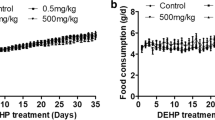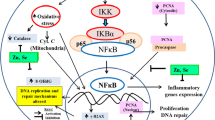Abstract
This study aimed to investigate the effects of di(2-ethylhexyl)phthalate (DEHP) on Sertoli-cell vimentin filaments and germ-cell apoptosis in testes of pubertal rats at different selenium (Se) status. Se deficiency was produced in 3-weeks old Sprague-Dawley rats by feeding them ≤0.05 Se mg/kg diet for 5 weeks, Se supplementation group was on 1 mg Se/kg diet, and DEHP was applied at 1000 mg/kg dose by gavage during the last 10 days of the feeding period. The diet with excess Se did not cause any appreciable alteration in vimentin staining and apoptosis of germ cells, but Se deficiency caused a mild decrease in the intensity of vimentin immunoreactivity and enhanced germ-cell apoptosis significantly (approximately 3-fold, p <0.0033). DEHP exposure caused disruption and collapse of vimentin filaments and significantly induced apoptotic death of germ cells (approximately 8-fold, p <0.0033). In DEHP-exposed Se-deficient animals, compared with the control, collapse of vimentin filaments was more prominent; there was serious damage to the seminiferous epithelium; and a high increment (approximately 25-fold, p <0.0033) in apoptotic germ cells was observed. Thus, Se deficiency exacerbated the toxicity of DEHP on Sertoli cells and spermatogenesis, whereas Se supplementation provided protection. These results put forward the critical role of Se in the modulation of redox status of testicular cells and emphasize the importance of Se status for reproductive health.




Similar content being viewed by others
References
Aitken RJ, Baker MA (2006) Oxidative stress, sperm survival and fertility control. Mol Cell Endocrinol 250:66–69
Alam MS, Ohsako S, Tay TW, Tsunekawa N, Kanai Y, Kurohmaru M (2010) Di(n-butyl)phthalate induces vimentin filaments disruption in rat Sertoli cells: a possible relation with spermatogenic cell apoptosis. Anat Histol Embryol 39:186–193
Allard EK, Johnson KJ, Boekelheide K (1993) Colchicine disrupts the cytoskeleton of rat testis seminiferous epithelium in a stage-dependent manner. Biol Reprod 48:143–153
Amlani S, Vogl AW (1988) Changes in the distribution of microtubules and intermediate filaments in mammalian Sertoli cells during spermatogenesis. Anat Rec 220:143–160
Bardin CW, Cheng CY, Musto NA, Gunsalus GL (1988) The Sertoli cell. In: Knobil E, Neill JD, Ewing LL, Greenwald GS, Markert CL, Pfaff DW (eds) The physiology of reproduction. Raven Press, New York, NY, pp 933–974
Barlow NJ, Phillips SL, Wallace DG, Sar M, Gaido KW, Foster PM (2003) Quantitative changes in gene expression in fetal rat testes following exposure to di(n-butyl)phthalate. Toxicol Sci 7:431–441
Behne D, Höfer T, von Berswordt-Wallrabe R, Elger W (1982) Selenium in the testis of the rat: studies on its regulation and its importance for the organism. J Nutr 112:1682–1687
Blount BC, Silva MJ, Caudill SP, Needham LL, Pirkle JL, Sampson EJ et al (2000) Levels of seven urinary phthalate metabolites in a human reference population. Environ Health Perspect 108:979–982
Borch J, Metzdorff SB, Vinggaard AM, Brokken L, Dalgaard M (2006) Mechanisms underlying the anti-androgenic effects of diethylhexyl phthalate in fetal rat testis. Toxicology 223:144–155
Dalgaard M, Nellemann C, Lam HR, Sørensen IK, Ladefoged O (2001) The acute effects of mono(2-ethylhexyl)phthalate (MEHP) on testes of prepubertal Wistar rats. Toxicol Lett 122:69–79
Diemer T, Allen JA, Hales KH, Hales DB (2003) Reactive oxygen disrupts mitochondria in MA-10 tumor Leydig cells and inhibits steroidogenic acute regulatory (StAR) protein and steroidogenesis. Endocrinology 144:2882–2891
Dröge W (2002) Free radicals in the physiological control of cell function. Physiol Rev 82:47–95
Durmaz E, Ozmert EN, Erkekoglu P, Giray B, Derman O, Hincal F et al (2010) Plasma phthalate levels in pubertal gynecomastia. Pediatrics 125:e122–e129
Erkekoglu P, Rachidi W, De Rosa V, Giray B, Favier A, Hincal F (2010a) Protective effect of selenium supplementation on the genotoxicity of di(2-ethylhexyl)phthalate and mono(2-ethylhexyl)phthalate treatment in LNCaP cells. Free Radic Biol Med 49:559–566
Erkekoglu P, Rachidi W, Yuzugullu OG, Giray B, Favier A, Ozturk M, Hincal F (2010b) Evaluation of cytotoxicity and oxidative DNA damaging effects of di(2-ethylhexyl)-phthalate (DEHP) and mono(2-ethylhexyl)phthalate (MEHP) on MA-10 Leydig cells and protection by selenium. Toxicol Appl Pharmacol 248:52–62
Erkekoglu P, Zeybek ND, Giray B, Asan E, Arnaud J, Hincal F (2011a) Reproductive toxicity of di(2-ethylhexyl)phthalate in selenium-supplemented and selenium-deficient rats. Drug Chem Toxicol 34:379–389
Erkekoglu P, Rachidi W, Yüzügüllü OG, Giray B, Oztürk M, Favier A et al (2011b) Induction of ROS, p53, p21 in DEHP- and MEHP-exposed LNCaP cells-protection by selenium compounds. Food Chem Toxicol 49:1565–1571
Fan J, Traore K, Li W, Amri H, Huang H, Wu C et al (2010) Molecular mechanisms mediating the effect of mono-(2-ethylhexyl) phthalate on hormone-stimulated steroidogenesis in MA-10 mouse tumor Leydig cells. Endocrinology 151:3348–3362
Fiorini C, Tilloy-Ellul A, Chevalier S, Charuel C, Pointis G (2004) Sertoli cell junctional proteins as early targets for different classes of reproductive toxicants. Reprod Toxicol 18:413–421
Fischer JL, Lancia JK, Mathur A, Smith ML (2006) Selenium protection from DNA damage involves a Ref1/p53/Brca1 protein complex. Anticancer Res 26:899–904
Flohé L (2007) Selenium in mammalian spermiogenesis. Biol Chem 388:987–995
Franke WW, Grund C, Schmid E (1979) Intermediate-sized filaments present in Sertoli cells are of the vimentin type. Eur J Cell Biol 19:269–275
Frederiksen H, Skakkebaek NE, Andersson AM (2007) Metabolism of phthalates in humans. Mol Nutr Food Res 51:899–911
Ganther DE (1999) Selenium metabolism, selenoproteins and mechanisms of cancer prevention: complexities with thioredoxin reductase. Carcinogenesis 20:1657–1666
Gazouli M, Yao ZX, Boujrad N, Corton JC, Culty M, Papadopoulos V (2002) Effect of peroxisome proliferators on Leydig cell peripheral-type benzodiazepine receptor gene expression, hormone-stimulated cholesterol transport, and steroidogenesis: role of the peroxisome proliferator-activator receptor alpha. Endocrinology 143:2571–2583
Hall ES, Eveleth J, Boekelheide K (1991) 2, 5-Hexanedione exposure alters the rat Sertoli cell cytoskeleton. II. Intermediate filaments and actin. Toxicol Appl Pharmacol 111:443–453
Hanukoglu I (2006) Antioxidant protective mechanisms against reactive oxygen species (ROS) generated by mitochondrial P450 systems in steroidogenic cells. Drug Metab Rev 38:171–196
Hess RA, Nakai M (2000) Histopathology of the male reproductive system induced by the fungicide benomyl. Histol Histopathol 15:207–224
Kasahara E, Sato EF, Miyoshi M, Konaka R, Hiramoto K, Sasaki J et al (2002) Role of oxidative stress in germ cell apoptosis induced by di(2-ethylhexyl)phthalate. Biochem J 365:849–856
Kaushal N, Bansal MP (2007) Dietary selenium variation-induced oxidative stress modulates CDC2/cyclin B1 expression and apoptosis of germ cells in mice testis. J Nutr Biochem 18:553–564
Kim JM, McGaughy JT, Bogle RK, Ravnik SE (2001) Meiotic expression of the cyclin H/Cdk7 complex in male germ cells of the mouse. Biol Reprod 64:1400–1408
Kluwe WM (1982) Overview of phthalate ester pharmacokinetics in mammalian species. Environ Health Perspect 45:3–9
Koch HM, Preuss R, Angerer J (2006) Di(2-ethylhexyl)phthalate (DEHP): Human metabolism and internal exposure―an update and latest results. Int J Androl 29:155–165
Kwack SJ, Kim KB, Kim HS, Lee BM (2009) Comparative toxicological evaluation of phthalate diesters and metabolites in Sprague-Dawley male rats for risk assessment. J Toxicol Environ Health A 72:1446–1454
Lyche JL, Gutleb AC, Bergman A, Eriksen GS, Murk AJ, Ropstad E et al (2009) Reproductive and developmental toxicity of phthalates. J Toxicol Environ 12:225–249
Noriega NC, Howdeshell KL, Furr J, Lambright CR, Wilson VS, Gray LE Jr (2009) Pubertal administration of DEHP delays puberty, suppresses testosterone production, and inhibits reproductive tract development in male Sprague-Dawley and Long-Evans rats. Toxicol Sci 111:163–178
Oberley TD, Zhong W, Szweda LI, Oberley LW (2000) Localization of antioxidant enzymes and oxidative damage products in normal and malignant prostate epithelium. Prostate 44:144–155
Olson GE, Winfrey VP, Hill KE, Burk RF (2004) Sequential development of flagellar defects in spermatids and epididymal spermatozoa of selenium-deficient rats. Reproduction 127:335–342
Richburg JH, Boekelheide K (1996) Mono-(2-ethylhexyl) phthalate rapidly alters both Sertoli cell vimentin filaments and germ cell apoptosis in young rat testes. Toxicol Appl Pharmacol 137:42–50
Richburg JH, Nanez A, Gao H (1999) Participation of the Fas-signaling system in the initiation of germ cell apoptosis in young rat testes after exposure to mono-(2-ethylhexyl) phthalate. Toxicol Appl Pharmacol 160:271–278
Roveri A, Casasco A, Maiorino M, Dalan P, Calligaro A, Ursini F (1992) Phospholipid hydroperoxide glutathione peroxidase of rat testis. Gonadotropin dependence and immunocytochemical identification. J Biol Chem 267:6142–6146
Seiler A, Schneider M, Förster H, Roth S, Wirth EK, Culmsee C et al (2008) Glutathione peroxidase 4 senses and translates oxidative stress into 12/15-lipoxygenase dependent- and AIF-mediated cell death. Cell Metab 8:237–248
Sen Gupta R, Sen Gupta E, Dhakal BK, Thakur AR, Ahnn J (2004) Vitamin C and vitamin E protect the rat testes from cadmium-induced reactive oxygen species. Mol Cells 17:132–139
Show MD, Anway MD, Folmer JS, Zikrin BR (2003) Reduced intratesticular testosterone concentration alters the polymerization state of the Sertoli cell intermediate filament cytoskeleton by degradation of vimentin. Endocrinology 144:5530–5536
Steinbrenner H, Sies H (2009) Protection against reactive oxygen species by selenoproteins. Biochim Biophys Acta 1790:1478–1485
Tay TW, Andriana BB, Ishii M, Tsunekawa N, Kanai Y, Kurohmaru M (2007) Disappearance of vimentin in Sertoli cells: A mono(2-ethylhexyl)phthalate effect. Int J Toxicol 26:289–295
Virtanen HE, Rajpert-De Meyts E, Main KM, Skakkebaek NE, Toppari J (2005) Testicular dysgenesis syndrome and the development and occurrence of male reproductive disorders. Toxicol Appl Pharmacol 207:501–505
Vogl AW, Pfeiffer DC, Redenbach DM, Grove BD (1993) Sertoli cell cytoskeleton. In: Russell LD, Griswold MD (eds) The Sertoli cell. Cache River Press, Clearwater, FL, pp 39–86
Wang ZQ, Watanabe Y, Toki A, Itano T (2002) Altered distribution of Sertoli cell vimentin and increased apoptosis in cryptorchid rats. J Pediatr Surg 37:648–652
Zikrin BR, Santulli R, Awoniyi CA, Ewing LL (1989) Maintenance of advanced spermatogenic cells in the adult rat testis: quantitative relationship to testosterone concentration within the testis. Endocrinology 124:3043–3049
Acknowledgments
This work was supported by Hacettepe University Research Fund [Project No: 0701301001].
Author information
Authors and Affiliations
Corresponding author
Rights and permissions
About this article
Cite this article
Erkekoglu, P., Zeybek, N.D., Giray, B. et al. The Effects of Di(2-Ethylhexyl)Phthalate Exposure and Selenium Nutrition on Sertoli Cell Vimentin Structure and Germ-Cell Apoptosis in Rat Testis. Arch Environ Contam Toxicol 62, 539–547 (2012). https://doi.org/10.1007/s00244-011-9712-9
Received:
Accepted:
Published:
Issue Date:
DOI: https://doi.org/10.1007/s00244-011-9712-9




